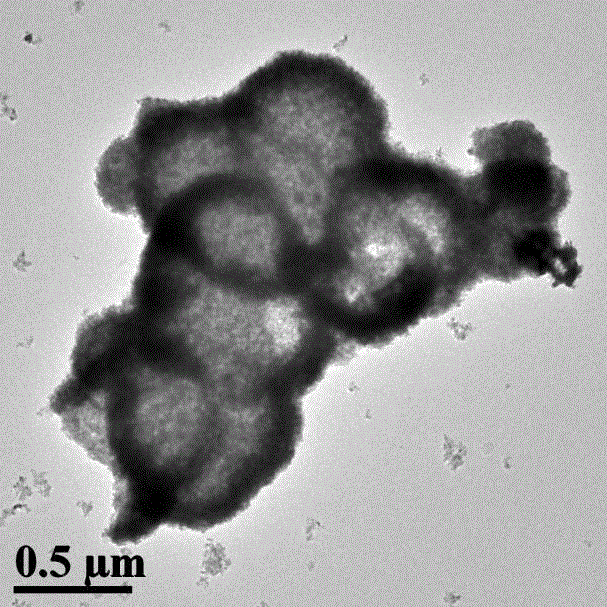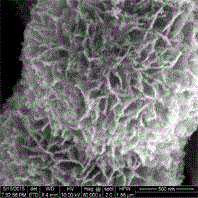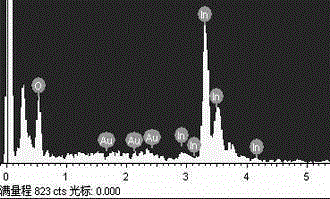Preparation method of indium oxide air-sensitive material having loaded gold nanoparticles in hollow and hierarchical structure
A gold nanoparticle and hierarchical structure technology, applied in nanostructure manufacturing, nanotechnology, nanotechnology, etc., can solve problems such as high-tech deep processing exploration is still in its infancy
- Summary
- Abstract
- Description
- Claims
- Application Information
AI Technical Summary
Problems solved by technology
Method used
Image
Examples
Embodiment 1
[0018] (1) Weigh a certain amount of indium chloride, L-cysteine and trisodium citrate and dissolve them in deionized water. The concentration of indium chloride is 0.05mol / L, and the concentration of L-cysteine is 0.1mol / L, the concentration of trisodium citrate is 0.05mol / L, and the molar ratio of control indium chloride and L-cysteine is 1:1.5, the mol ratio of indium chloride and trisodium citrate is 1:1;
[0019] (2) Move the mixed solution obtained in step (1) to a hydrothermal reaction kettle lined with polytetrafluoroethylene, and conduct a hydrothermal reaction at a temperature of 170°C for 16 hours, and then use the product after the hydrothermal reaction The centrifuge is used for solid-liquid separation, and the obtained solid product is washed several times with deionized water and ethanol;
[0020] (3) Place the solid product obtained in step (2) in a drying oven, dry at 60°C for 24 hours, then put it in an alumina crucible and put it in a muffle furnace, an...
Embodiment 2
[0024] (1) Weigh a certain amount of indium chloride, L-cysteine and trisodium citrate and dissolve them in deionized water. The concentration of indium chloride is 0.06mol / L, and the concentration of L-cysteine is 0.15mol / L, the concentration of trisodium citrate is 0.06mol / L, and the molar ratio of control indium chloride and L-cysteine is 1:2, the mol ratio of indium chloride and trisodium citrate is 1:1;
[0025] (2) Move the mixed solution obtained in step (1) to a hydrothermal reaction kettle lined with polytetrafluoroethylene, and conduct a hydrothermal reaction at a temperature of 180°C for 18 hours, and then use the product after the hydrothermal reaction The centrifuge is used for solid-liquid separation, and the obtained solid product is washed several times with deionized water and ethanol;
[0026] (3) Place the solid product obtained in step (2) in a drying oven, dry at 60°C for 24 hours, then put it in an alumina crucible and put it in a muffle furnace, and...
Embodiment 3
[0030] (1) Weigh a certain amount of indium chloride, L-cysteine and trisodium citrate and dissolve them in deionized water. The concentration of indium chloride is 0.067mol / L, and the concentration of L-cysteine is 0.133mol / L, the concentration of trisodium citrate is 0.067mol / L, and the molar ratio of controlling indium chloride and L-cysteine is 1:2, the mol ratio of indium chloride and trisodium citrate is 1:1;
[0031] (2) Move the mixed solution obtained in step (1) to a hydrothermal reaction kettle lined with polytetrafluoroethylene, conduct a hydrothermal reaction at a temperature of 190°C for 20 hours, and then use the product after the hydrothermal reaction The centrifuge is used for solid-liquid separation, and the obtained solid product is washed several times with deionized water and ethanol;
[0032] (3) Place the solid product obtained in step (2) in a drying oven, dry at 60°C for 24 hours, then put it in an alumina crucible and put it in a muffle furnace, ...
PUM
 Login to View More
Login to View More Abstract
Description
Claims
Application Information
 Login to View More
Login to View More - R&D
- Intellectual Property
- Life Sciences
- Materials
- Tech Scout
- Unparalleled Data Quality
- Higher Quality Content
- 60% Fewer Hallucinations
Browse by: Latest US Patents, China's latest patents, Technical Efficacy Thesaurus, Application Domain, Technology Topic, Popular Technical Reports.
© 2025 PatSnap. All rights reserved.Legal|Privacy policy|Modern Slavery Act Transparency Statement|Sitemap|About US| Contact US: help@patsnap.com



